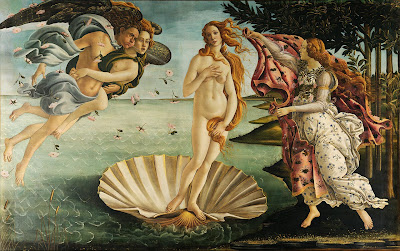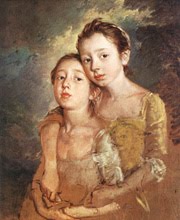Why do we make art- why do I make art? What kind of art should be made today or is there an end to what we conceive is art? Is it pointless, is it futile in our present culture? We are inundated with artists and art today-even in mid 19th century there were 2000 practicing artists in Paris. Degas complained about the numbers as well. Jacques Barzun
http://en.wikipedia.org/wiki/Jacques_Barzun decried the fact that even the most marginally talented are encouraged - fans flaming every little daycare Picasso. How much to I want to add to this glut- what do I want to add to this contemporary 'Everest' of 'art'?
I do not know and I doubt that I am alone in this quandary.
However, an artist is what I am compelled to be, so even at 70 I must somehow get on with it.
What indeed to paint?
How did we get from this, two years to create:
 |
| Sandro Botticelli "The Birth of Venus " 1483- 1485 |
to this?
 |
| Jean-Michel Basquiat "Philistines" 1982 |
In total confusion I ricocheted around the internet, subscribed to the New Criterion, read art reviews from the New York Times to the Guardian, art critics both contemporary and dead. I inserted the words sublime, exquisite, beautiful, beautifully crafted. The only contemporary reviews that made use of these words were of art done before 1920. Even Hilton Kramer http://en.wikipedia.org/wiki/Hilton_Kramer rarely if ever used those words in his book "The Age of the Avante-Garde" or in much of his contemporary reviews. I barely see them in "The New Criterion" the critical review he founded after leaving his position as the art critic of the New York Times.
Jonathan Jones, the Guardian art blogger asks "What's Happened to Figurative Art?"
He argues that we cannot go back:
I've spent the last few days immersed in a world of oil, gesso and cartone paper, of workshops and apprentices and guilds. I've been writing about the Italian Renaissance, and writing can be a form of time travel. You find yourself, for a moment, in a world when art was a craft; when levels of skill were so mind-boggling that it's easier to take them for granted and concentrate on the meanings and ideas - because to comprehend the technical achievement of a Botticelli or a Leonardo is all but impossible.
There is a profound difference between art rooted in craft, and art that has no interest in it. In this century, art has left craft far behind. A process that began when Marcel Duchamp insisted art should appeal only to the brain is, today, complete. Painters who know how to paint are relics from another world and sculpture no longer seems the right word for the objects artists find or cause to be made.
Is this a tragedy? Yes, it is. But can the clock be turned back? No, it can't. Often, if I write about, say, Constable's portraits I will get inundated with press releases from artists who paint portraits, who feel excluded from the world of the Turner prize and Tate Modern. There are many people in Britain today who would claim their art is based in craft and the study of nature. They look at the conceptual art establishment and feel rage, exclusion, rejection. If a critic says something like I said in my first paragraph, they cheer. But I've got a question for figurative artists: if the greatest art is that of a Michelangelo or a Titian, if what really matters is the truthful picturing of the world with love and craft - why is it you think you measure up?
I have seen little that disputes what Jones has to say even though there has been an explosion of Portrait Societies and portrait competitions from the US to the Antipodes. Barzun posited that there are few portraits done after the advent of photography that are really compelling. I agree with him and certainly few in any are as powerfully engaging as this small exquisite El Greco that mesmerized me when I was in art school at the Boston Museum.
Back to Mr. Barzun:
 |
| Fray Hortensio Félix Paravicino 1609 44" x 33" |
His books have become a discovery and a joy. I recommend every artist, writer, poet or musician read his books. His magnus opus: From "Dawn to Decadence"
was written when he was 92 and published in 2000. It covers the cultural, political and scientific arc from 1500 to the end of the millennium. He explains the effect each era had on the point of view and styles of the arts of the salient societies that created them, deftly relating how we got from the sublime to the present endgame destructiveness of Marcel Duchamp's anti-art Dadaism. He by the way is no fan of the over polished literalism of the French Academy and nether am I.
There are some that quibble with his assessment that the Romanticists were the apotheosis of music and art especially Berlioz. I think he is somewhat dismissive of Mozart. He is not so surefooted on the reasons for a welfare society and from what I have read was quite aloof from( and possibly disagreed with ) the students who protested the Vietnam war at Columbia University. I do not find theses reasons enough to dismiss this admirable book- even though I personally disagree with him.
There are some that quibble with his assessment that the Romanticists were the apotheosis of music and art especially Berlioz. I think he is somewhat dismissive of Mozart. He is not so surefooted on the reasons for a welfare society and from what I have read was quite aloof from( and possibly disagreed with ) the students who protested the Vietnam war at Columbia University. I do not find theses reasons enough to dismiss this admirable book- even though I personally disagree with him.
I have read his "The Uses and Abuses of Art", "The Culture We Deserve" and "From Dawn to Decadence" a powerful cultural literary trinity that has helped me realign with what gives me joy and purpose in the creating of art and a clue as how to proceed with something I love.
Last night another piece from a surprising quarter fell into place: Bill Moyer's interview with Wendell Berry, (born August 5, 1934) is an American novelist, poet, environmental activist, cultural critic, and farmer. http://en.wikipedia.org/wiki/Wendell_Berry
Mr Berry, an eloquent, endearing, humble and patient man decries the destructiveness of the strip-mining (among other environmental evils) in his native Kentucky. It is poisoning the water around his farm and killing the Black Willows. He say he will not allow his place, his planet to be overrun by the forces of corporate greed. We must have a sense of the precious. That one word 'precious'" to me said it all.
That is what we have lost- the sense of the 'precious'. I think we have lost that in art as well- can it be regained?
Here is a link to some of Barzun's writing from "The American Scholar".http://theamericanscholar.org/to-the-rescue-of-romanticism/#.UojjpNI3vKh
Contrast this intelligent observation to the contemporary art brawl/crawl that is Art Basel Miami where the party is more important than the 'art'.
And finally a current art dealers take on what she thinks art is in the New York Times, December 1st 2013.
“Objects have their own integrity and energy, which is something people who live among objects understand,” Ms. Greenberg Rohatyn ( Art Dealer) said. “They speak to each other, creating a dialogue, which is what personally gets my heart beating.”











No comments:
Post a Comment